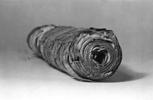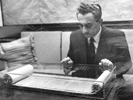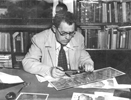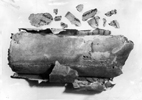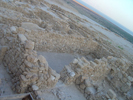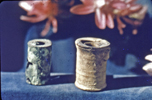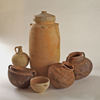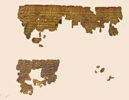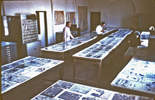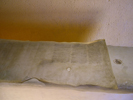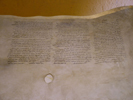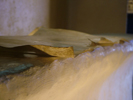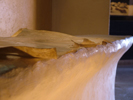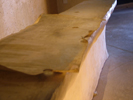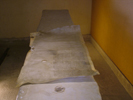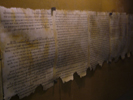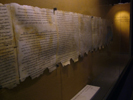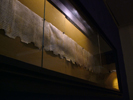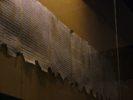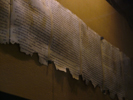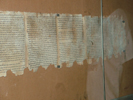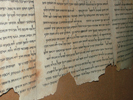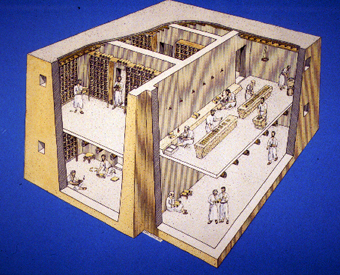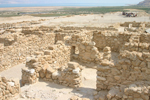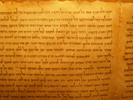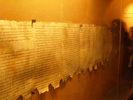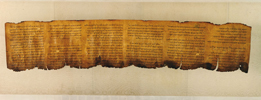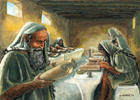Scriptorium

Introduction
De Vaux’s identification of scribes workshop clearly reflects his tendency to interpret the archaeology of the Qumran settlement in light of the manuscript finds from the Scriptorium. We can be reasonably sure that this room was used for writing, since two inkwells were found here, along with a third in an adjacent room. Inkwells are not common archaeological finds in Israel. One objection that has been raised to the identification of this room as a scriptorium is that no writing utensils or writing skins were found at the settlement. However, this argument from silence is not relevant—the inkwells were clearly used for writing, and there is no reason to expect that more perishable materials would have survived.
De Vaux’s hypothesis was challenged, however, especially on the basis of his identification of the remains of furniture found in this room as “writing tables” and a “writing bench.” Archaeologists have not yet succeeded in determining the actual purpose of this furniture, which seems to have fallen from an original second story. When these items were prepared for display at the Rockefeller Museum, they were reconstructed to accommodate De Vaux’s interpretation. There is no evidence, though, that scribes of that period used scribal tables and benches. Robert Donceel and Pauline Donceel-Voûte have argued that this room was actually a triclinium (dining hall), and the unusual pieces of furniture were benches upon which the diners would recline, in the Greco-Roman manner. It appears, however, that the “benches” would have been too narrow for this purpose.
Today there is varied opinion as to exactly which scrolls might have been physically written at Qumran. If indeed the group that produced the sectarian texts lived at Qumran, there might be elements to identify their work. The sectarian scrolls and some biblical manuscripts (e.g., 1QIsaa) share a number of characteristics that differ from those of other Second Temple sources, and thus suggest that they were produced within a single community setting. Emanuel Tov has termed these shared distinctive features the “Qumran Scribal practice.” One important Qumran scribal feature is the style of spelling (“orthography”). In the Hebrew language not all vowel sounds are represented by letters. When the vowel sounds are represented graphically by consonants aleph, heh, vav, and yod (known as matres lectionis), the spelling is called plene "full; when" the consonants are omitted, the spelling is termed defective. Qumran orthography is consistently “full.” In some documents, the spelling may be described as “ultra-full”—that is, even more than one consonant may be used to represent a vowel sound. Thus, the word ki “because, for,” which in biblical Hebrew is spelled with the consonants kaph and yod (כי), is frequently spelled at Qumran with an additional final aleph (כיא).
Because no manuscript fragments were actually found in the Qumran complex itself, however, the only material link between the site and the surrounding Scriptorium is the pottery found in both (including the jars in which some of the scrolls were found, which appears to have been manufactured at the site; see Qumran Pottery.
More Info
- Frank Moore Cross. The Ancient Library of Qumran. 3rd ed. Minneapolis: Fortress, 1995.
- Robert Donceel and Pauline Donceel-Voûte, “The Archaeology of Qumran,” in Methods of Investigation of the Dead Sea Scrolls and the Khirbet Qumran Site: Present Realities and Future Prospects. Ed. by Michael O. Wise [et al.]. New York: New York Academy of Sciences, 1994, pp. 1–38.
- Jodi Magness, “What do Pottery and Architecture Tell Us about Qumran,” in The Archaeology of Qumran and the Dead Sea Scrolls (Grand Rapids; Eerdmans, 2002), 73-104.
- Elisha Qimron, The Hebrew of the Dead Sea Scrolls. Scholars Press: Atlanta, Georgia, 1986, pp. 17-24.
- Ronny Reich, “A Note on the Function of Room 30 (the ‘Scriptorium’) at Khirbet Qumran,” JJS 46 (1995), pp. 157-160.
- Emanuel Tov, Scribal Practices and Approaches Reflected in the Texts Found in the Judean Desert. Leiden: Brill, 2004.
